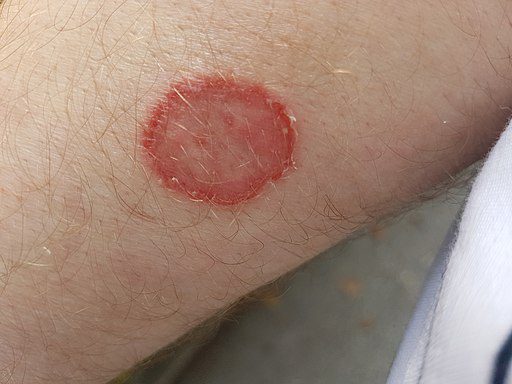Two separate cases of severe ringworm that did not respond to antifungal treatment are discussed in a new case report from the Centers for Disease Control and Prevention (CDC). It marks the first time that known cases of drug-resistant ringworm have been identified in the US, and has sparked fears that the pathogen responsible may be making moves into new territories.
Contrary to what its name suggests, ringworm has nothing to do with worms. It’s a fungal skin infection, caused by a group of organisms called dermatophyte molds. The disease is also referred to as tinea, and it usually manifests as an itchy, circular rash.

Circular lesions like this are typical of ringworm.
Many different areas of the skin can be affected, often including the hands, arms, and legs. Ringworm of the feet is more commonly referred to as “athlete’s foot”. Dermatophytes are also responsible for infections of the groin and buttocks, the evocatively named “jock itch”. Ringworm of the scalp, which is more common in children than adults, can lead to patches of hair loss.
Ringworm is highly contagious. You can catch it from close contact with infected people or animals. It can also spread from one area of the body to another, and fungal spores can spread between people via surfaces such as towels and bedding.
Infections are rarely serious or fatal, but it’s still not a pleasant condition, and there is a risk of secondary bacterial infections if the rash and skin lesions get worse.
Around 40 different species of fungi can cause ringworm, but most of them belong to the genus Trichophyton. The two cases identified in the CDC report were found to have been caused by Trichophyton indotineae, a relatively new addition to the fungal family which has never before been seen in a patient in the US.
What makes T. indotineae so concerning for health officials is that it is often resistant to terbinafine, a very common drug that is used to treat ringworm and other fungal infections. Indeed, the two patients described in the case report were both treated with this drug and did not see an improvement in their symptoms.
Patient A in the CDC report developed the characteristic rash in 2021 whilst pregnant. After the birth of her child in early 2022, she was treated with terbinafine. When this didn’t work, she was given a different drug, itraconazole, which did clear up the infection. She is still being monitored in case it comes back.
Patient B first noticed symptoms while visiting Bangladesh in summer 2022. Back in the US, she was treated with several different creams and medications, including terbinafine. Eventually, the doctors turned to a different drug, griseofulvin, which improved the symptoms by about 80 percent. Patient B – as well as her husband and son, who may also now be infected – is still being monitored in case she needs further medication.
The two cases were raised to the CDC by a New York City dermatologist in February 2023, and an investigation was started. Since these two cases are separated by both time and geography, it’s not thought that they are directly related. However, since Patient A had no history of international travel, it does point to transmission of T. indotineae taking place inside the US, which has not been seen before.
The specter of antimicrobial resistance has been hanging over the medical field for some years now. We’re used to hearing about this in reference to bacterial infections, but drug-resistant fungi are another potential threat to public health. The CDC stress that suspected T. indotineae cases should be reported to local or state public health authorities, and reiterate the continued importance of avoiding the misuse and overuse of antifungal drugs.
Ringworm is thankfully not the sort of disease you might associate with a The Last of Us-style catastrophe. But any suggestion that drug-resistant strains are spreading, no matter how rarely, is something health officials are going to take very seriously indeed.
The study is published in the CDC’s Morbidity and Mortality Weekly Report.
Source Link: First Ever Drug-Resistant Ringworm Cases In US Identified By CDC